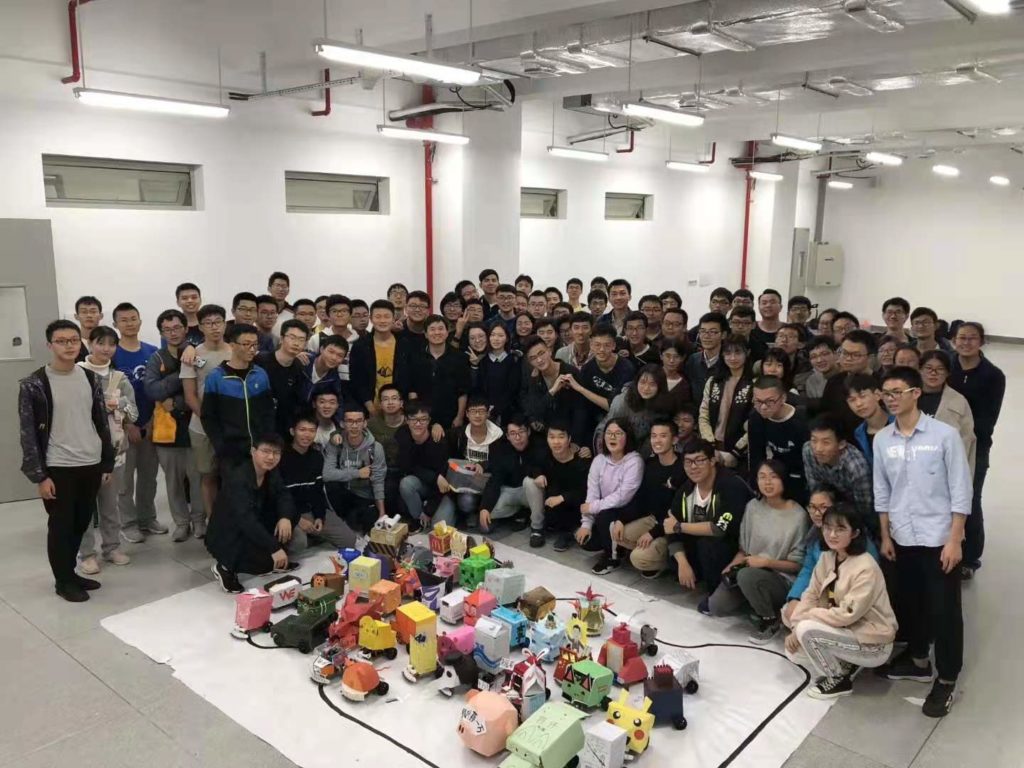《机器人设计与实践》
(2022年改名为《自动化专业认知与实践)
该课程将于2022年拓展为4学分必修课,涵盖自动化专业导论、工程制图以及机器人设计实践相关内容。内容进一步合理,教学方式创新,将是哈工大深圳自动化专业的重量级课程,非常值得期待。
- 本课程面向自动化专业大一新生,是新生深刻理解自动化专业的重要窗口,是新生接受专业入门教育的重要课程。课程承接《自动化专业导论》的教学内容,以轮式机器人这一类典型自动化系统为教授对象,将重点围绕移动机器人小车的SolidWorks机械设计、基本电子电路入门、电机驱动与反馈、逻辑控制器编程与传感器入门、机器人基本控制理论和轮式机器人数学建模与控制等方面展开,通过实验实践为主、课堂教学为辅、以学生为核心的翻转课堂方式,使学生对轮式机器人这类自动化系统的各子系统及其集成有较为深刻的理解。通过本课程的学习,学生能够达到的目标描述如下:
- 1. 建立起对轮式机器人的感性和理性认识,包括内涵、本质和外延、应用范围和作用等;了解轮式机器人的基本机械结构、基本电子电路以及自动化科学与技术的核心内容;通过轮式机器人这一典型系统,建立对自动化系统的感性和理性认识; 了解我校及自动化专业的人才培养目标,了解专业人才完整的知识结构及能力与素质要求,了解专业的课程体系结构及设计理念。
- 2. 通过循序渐进且系统的课程上机、实验以及课外制作,从实践中深入体会自动化系统的各个核心子系统的组成、应用以及潜在的问题,强化学生对实际问题的分析、综合和解决能力,增强学生的工程实现能力,培养学生学习后续课程的积极性和主动性。
- 先修课程:C语言程序设计,自动化专业导论
- 参考教材: MIT Course System – Adam Hartz等,Course Notes of Introduction to EECS via Robotics, 2016.

《数字图像处理》
Digital image processing technology is the foundation of pattern recognition, computer vision, image understanding and so on, and it is an intersection subject involving many fields. Through the study of this course, students require more in-depth understanding of the basic theories and basic methods of digital image processing, and learn digital image information representation, analysis and processing methods. The course covers the following three aspects: (1) to improve image quality for better analysis, such as image enhancement, image restoration, color transformation. (2) to facilitate automatic machine understanding to extract features or specific information from a digital image, such as frequency analysis, morphological processing, image segmentation, representation and description. (3) image coding and compression for image storage and transmission.
- 《数字图像处理》课程是自动化类智能感知与系统专业方向的必修课程。实验教学是《数字图像处理》课程教学中重要的实践环节。与课程内容所教授概念和理论内容相对应,通过设立一些综合性、设计性实验,着重培养学生们对课堂知识的掌握和应用能力,增加创新意识,支撑专业学习成果中相应指标点的达成。本门实验课程为进一步学习机器视觉和移动机器人系统等课程打下必要的实践基础。课程目标对学生的能力要求如下:
- 目标1. 了解和掌握数字图像的处理方法和数学分析方法,具备分析和解决工程实践中图像系统问题的能力;
- 目标2. 熟悉和掌握常见数字图像处理问题的基本实验技能和计算机编程方法,得到实验方案设计和实验技能获得的基本训练,逐步具有应用先进工具解决工程实际问题的能力。
- 先修课程Prerequisites: 数学分析;高等代数;信号分析与处理;数据结构与算法
- 主要教材(Main teaching materials):
- Digital Image Processing (Third Edition), Rafael C. Gonzalez, Richard E. Woods, Publishing House of Electronics Industry, ISBN 9787121102073, 2010.1
- K. Castleman 著, 朱志刚,石定机等译. 数字图像处理. 电子工业出版社. 2010.
- 图像工程,章毓晋,清华大学出版社, 2006
- 吴朝福. 计算机视觉中的数学方法. 科学出版社. 2011.
《机器视觉》
Machine vision is to use machines to replace human eyes do measurement and judgment, which is an important field of research and application of artificial intelligence. It is an important optional course for the students with major in automation and mechanical engineering. This course makes students to master the general principles of machine vision theory and application, and the key problems, including: the type, pros and cons, and selection method of machine vision lighting, basic optics and lens, parameters of lens and its influence to image quality, camera sensors, interface and their characteristics, algorithms of machine vision, such as edge detection, feature extraction and segmentation, object detection, barcode and data matrix recognition, 3D measurement. The purpose of this course is to enable students to master the basic theory and skills of machine vision and to cultivate the practical abilities, including the programming, basic machine vision algorithms and the practical problem solving.
- 机器视觉用机器代替人眼来做测量和判断,是人工智能的重要研究和应用领域,是自动化专业的一门重要专业方向选修课。本课程通过理论和实践教学使学生掌握机器视觉理论与应用的一般原理, 内容包括:视觉光源的种类、优缺点及选择方法;基础光学及镜头,镜头参数及对成像质量的影响;相机传感器、接口及特性;机器视觉处理算法,例如边缘检测、特征提取、分割、目标定位、字符条码识别、三维测量等,达到培养学生设计并分析机器视觉系统实际工作能力的目的。通过本课程的学生使学生掌握机器视觉的基本理论和基本技能;培养实际动手能力,包括编程能力、基本的视觉算法实现和实际问题解决能力。
- 先修课程Prerequisites: 线性代数;数字图像处理;C语言程序设计
